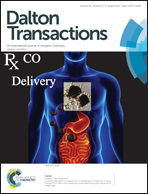Complexation of uranium(vi) with glutarimidoxioxime: thermodynamic and computational studies†
Abstract
The complex formation between a cyclic ligand glutarimidoxioxime (denoted as HLIII in this paper) and UO22+ is studied by potentiometry and microcalorimetry. Glutarimidoxioxime (HLIII), together with glutarimidedioxime (H2LI) and glutardiamidoxime (H2LII), belongs to a family of amidoxime derivatives with prospective applications as binding agents for the recovery of uranium from seawater. An optimized procedure of synthesis that leads to the preparation of glutarimidoxioxime in the absence of other amidoxime byproducts is described in this paper. Speciation models based on the thermodynamic results from this study indicate that, compared with H2LI and H2LII, HLIII forms a much weaker complex with UO22+, UO2(LIII)+, and cannot effectively compete with the hydrolysis equilibria of UO22+ under neutral or alkaline conditions. DFT computations, taking into account the solvation by including discrete hydration water molecules and bulk solvent effects, were performed to evaluate the structures and energies of the possible isomers of UO2(LIII)+. Differing from the tridentate or η2-coordination modes previously found in the U(VI) complexes with amidoxime-related ligands, a bidentate mode, involving the oxygen of the oxime group and the nitrogen of the imino group, is found to be the most probable mode in UO2(LIII)+. The bidentate coordination mode seems to be stabilized by the formation of a hydrogen bond between the carbonyl group of HLIII and a water molecule in the hydration sphere of UO22+.


 Please wait while we load your content...
Please wait while we load your content...